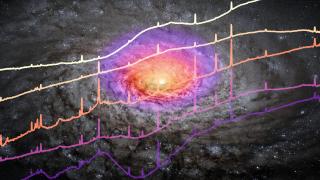Bibcode
Alonso Herrero, A.; García-Burillo, S.; Pereira-Santaella, M.; Shimizu, T.; Combes, F.; Hicks, E. K. S.; Davies, R.; Ramos Almeida, C.; García-Bernete, I.; Hönig, S. F.; Levenson, N. A.; Packham, C.; Bellocchi, E.; Hunt, L. K.; Imanishi, M.; Ricci, C.; Roche, P.
Bibliographical reference
Astronomy and Astrophysics
Advertised on:
7
2023
Journal
Citations
24
Refereed citations
20
Description
We present new ALMA observations of the CO(3−2) transition and associated 854 μm continuum at 0.06 − 0.3″ resolution, together with new VLT/SINFONI observations of NGC 7172. This is a luminous (bolometric luminosity of ≃1044 erg s−1) Seyfert galaxy that belongs to the Galaxy Activity, Torus, and Outflow Survey (GATOS). The ALMA CO(3−2) observations reveal the presence of a highly inclined cold molecular gas ring with an approximate radius of 3 − 4″ ≃ 540 − 720 pc, which is likely associated with an inner Lindblad resonance of a putative stellar bar. There are noncircular motions in the VLT/SINFONI [Si VI]λ1.96 μm and H2 at 2.12 μm, and ALMA CO(3−2) velocity fields. After subtracting the stellar velocity field, we detected [Si VI] blueshifted velocities of a few hundred km s−1 to the south of the active galactic nucleus (AGN) position. They trace outflowing ionized gas outside the plane of the galaxy and out to projected distances of ≃200 pc. The CO(3−2) position-velocity diagram along the kinematic minor axis displays noncircular motions with observed velocities of up to ∼150 km s−1. Assuming that these are taking place in the disk of the galaxy, the observed velocity signs imply that the molecular gas ring is not only rotating but also outflowing. We derived an integrated cold molecular gas mass outflow rate of ∼40 M⊙ yr−1 for the ring. Using the ALMA 854 μm extended emission map, we resolved a 32 pc radius torus with a gas mass of 8 × 105 M⊙. These torus properties are similar to other Seyfert galaxies in the GATOS sample. We measured a decreased cold molecular gas concentration in the nuclear-torus region relative to the circumnuclear region when compared to other less luminous Seyfert galaxies. We conclude that the effects of AGN feedback in NGC 7172, which are likely caused by the AGN wind and/or the moderate luminosity radio jet, are seen as a large-scale outflowing molecular gas ring and accompanying redistribution of molecular gas in the nuclear regions.
Related projects

Nuclear Activity in Galaxies: a 3D Perspective from the Nucleus to the Outskirts
This project consists of two main research lines. First, the study of quasar-driven outflows in luminous and nearby obscured active galactic nuclei (AGN) and the impact that they have on their massive host galaxies (AGN feedback). To do so, we have been granted time with the Gran Telescopio CANARIAS (GTC) in the optical and near-infrared ranges
Cristina
Ramos Almeida